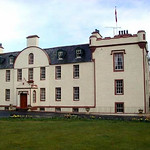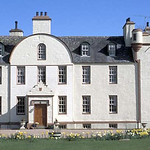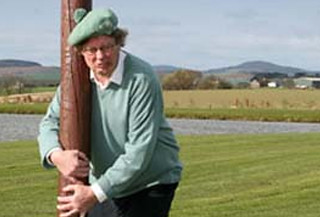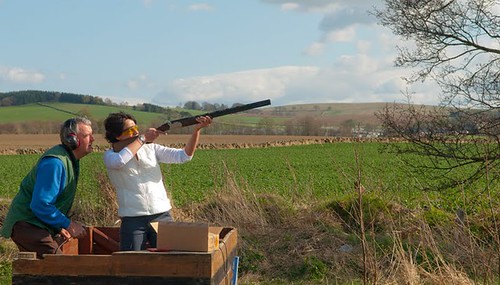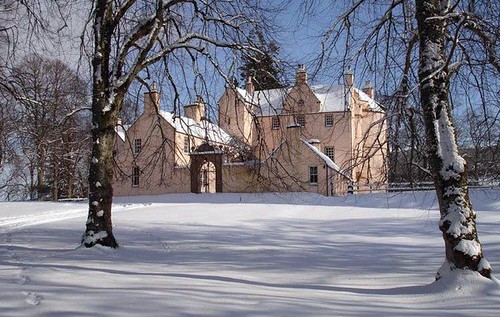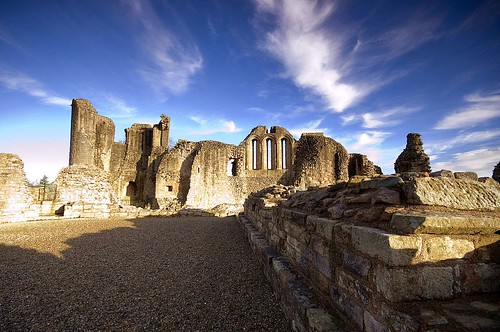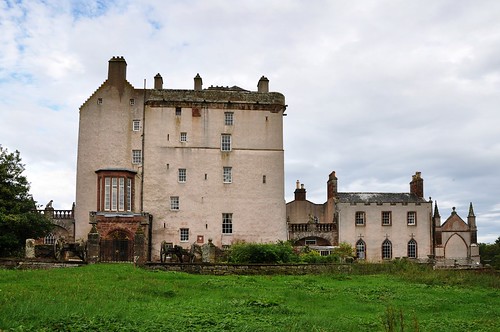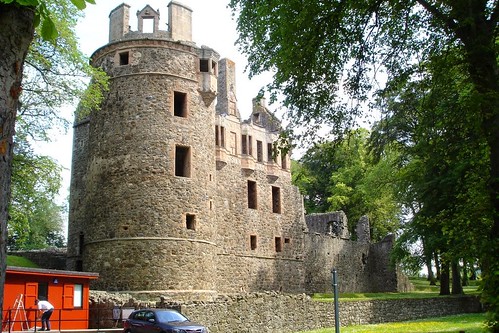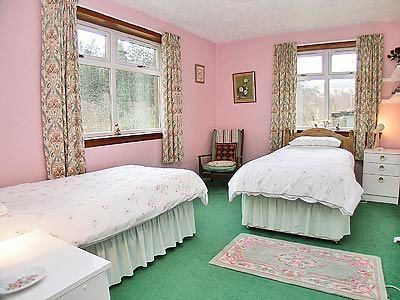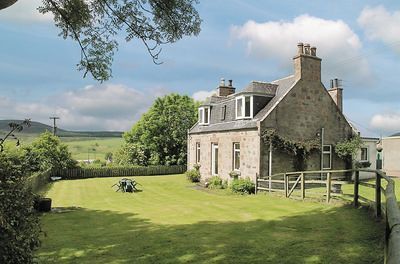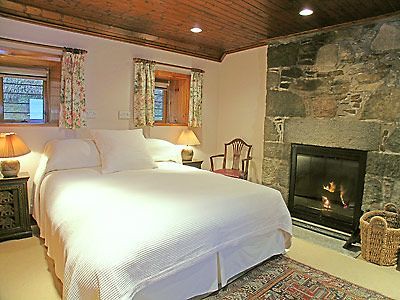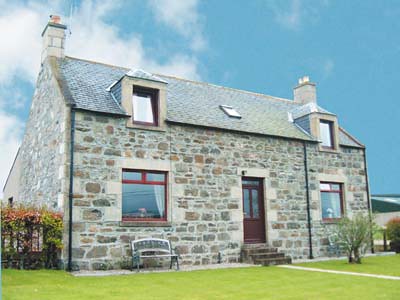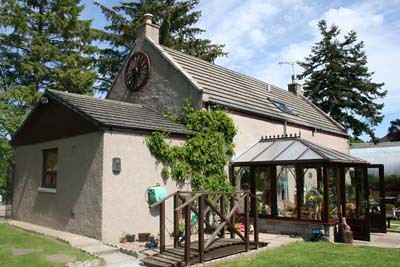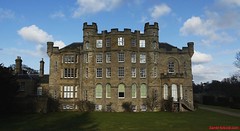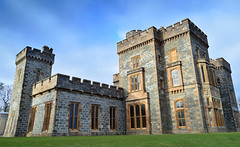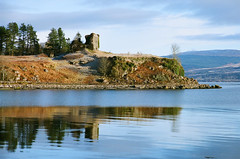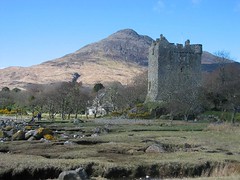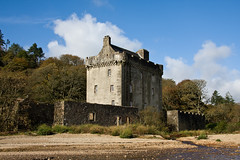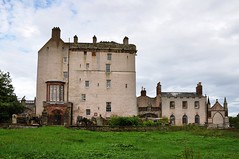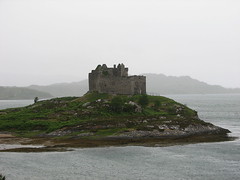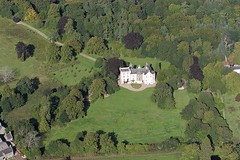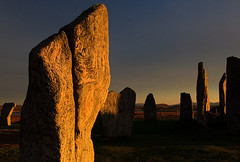Frendraught Castle
Site of 13th century castle, which was torched in 1630. The present house dates from 1656, was remodelled in 1753, extended to 1790, and incorporates a small part of the old castle.
It was a property of the Crichton family and was visited by James V in 1535. The castle tower was burnt down in 1630 during a feud over land with the Gordons who were with the Leslies actual cousins of the Crichtons. Six of the Gordons, including John Gordon, Lord Rothiemay, and Viscount Aboyne were burned and killed in the Castle, although the Crichton laird escaped with his folk. The laird, Crichton of Frendraught was tried and acquitted of their murders, although one of his servants was executed (instead).
Lady Rothiemay believed in Crichton's involvement as she later employed a number of highlanders to attack and plunder his lands and family. Lady Rothiemay herself was imprisoned in 1635 for these crimes, although she was later released.
Crichton's son, James, was made Viscount Frendraught in 1642, and although an avowed Covenanter, fought for the Marquis of Montrose in 1650. He was captured after being wounded and died soon thereafter.
The property then passed to the Morrisons about 1690. The house was restored in 1974 and is still occupied.
The present house contains only a small part of the original castle.
The story of the burning of the castle and the ensuing judicial proceedings are told below in the customary breathless historical prose.
THE Crichtons are an ancient Scottish family, but their origin is unknown. They derived their surname from the barony of Crichton, in the county of Edinburgh. A Thurstanus de Crichton is one of the witnesses to the charter founding the Abbey of Holyrood, in the days of David I., and a Thomas de Crichton was one of the barons who swore fealty to Edward I. in 1296. The family, however, appear to have remained in the rank of minor barons, taking no prominent part in public affairs till near the middle of the fifteenth century, when they suddenly rose to almost supreme power in the State through the great abilities and political address of Sir William Crichton, the famous Chancellor of Scotland during the minority of James II. This able and accomplished but unscrupulous statesman held in succession the offices of Chamberlain to the King, Master of the Household, and Governor of Edinburgh Castle before he became Chancellor and Lord Crichton. His rivalry with Sir Alexander Livingstone, the King’s Governor, his feuds with the great house of Douglas, and the prominent part which he took in the hasty execution of Earl William and his brother in 1440, are familiar to all the readers of Scottish history. In spite of various reverses of fortune, the Chancellor retained the confidence and favour of his sovereign until his death in 1454, shortly before the complete success of his policy in the triumph of the King over the Earl of Douglas and the total ruin of the potent family of the ‘Black Douglases.’ The cousin of the Chancellor was High Admiral of Scotland, and no doubt through his influence was created Earl of Caithness in 1452. Lord Crichton’s grandson was the son-in-law of James II., and is said to have seduced the sister of James III. in revenge for that monarch having dishonoured his bed. He took part in the unsuccessful rebellion of the Duke of Albany against his brother King James, and was in consequence attainted for treason, and stripped of his titles and estates. His magnificent castle of Crichton, on the banks of the north Tyne, which Sir Walter Scott describes in most picturesque terms in his poem of ‘Marmion,’ was conferred upon Ramsay of Balmain, and afterwards became the seat of the Hepburns. On the forfeiture of the notorious Earl of Bothwell, Crichton fell to the Crown, and was granted to Francis Stewart, Earl of Bothwell, who was a thorn in the side of his kinsman, King James VI. It has since passed through the hands of several proprietors.
Sir James Crichton, the fifth in descent from the forfeited peer, inherited the barony of Frendraught, in Banffshire, which came into the family through the wife of James, second Lord Crichton—Lady Jane Dunbar, eldest daughter and co-heiress of James, Earl of Moray. The grandson of this Sir James is the person implicated in the terrible tragedy called ‘The Burning of Frendraught,’ which, as Mr. Burton remarks, has to the northern peasant as distinct a tragic phase in history as the Sicilian Vespers or the night of St Bartholomew has to the Italians or the French. The barony of Frendraught is situated in the heart of the country of the great family of the Gordons, whose power had now become so formidable that the Court endeavoured to counterbalance and weaken the influence of the Marquis of Huntly, the head of the house of Gordon, by cherishing and strengthening the Crichtons as territorial rivals. As yet no open feud had broken out between the two houses, but various disputes had arisen which seemed likely to lead to open hostilities.
On the 1st of January, 1630, an encounter had taken place between the Crichtons, who were seeking to enforce a legal decision in their favour, and a party of Gordons, who were resisting its execution, in which several persons were hurt, and an important member of the latter family, Gordon of Rothiemay, was killed.
The whole clan was, of course, roused to demand vengeance, but no legal steps were taken to bring the guilty parties to justice, and the Gordons, taking into their own hands the right of redress, began to plunder the lands of Frendraught. The Crichtons were the weaker party, and seemed about to be pushed to the wall, when the Privy Council interfered for their protection, and sent a commission to appease the strife which this untoward affair had excited. When Sir Robert Gordon (historian of the house of Gordon), and the other commissioners reached the scene of action in May, 1630, they found a notorious outlaw, named James Grant, and two hundred Highlanders assembled at Rothiemay, ready to lay waste Frendraught’s estate with fire and sword. The remonstrances of the commissioners would in all probability have been utterly disregarded but for the interference of the Marquis of Huntly, the head of the house of Gordon. This great feudal chief, then a man about seventy years of age, was anxious that the feud should be ‘compounded,’ and in the end, through his mediation, the Crichtons agreed to pay to the widow and children of the slaughtered Rothiemay the sum of 50,000 merks (£2,915) as an ‘assythment,’ as it was called, or composition for his death.
Such a settlement for manslaughter was not uncommon at this period, and was not considered in any way dishonourable. This arrangement, it seems, was finally adjusted during a visit paid by Frendraught to the Marquis of Huntly. ‘And so,’ says Sir Robert Gordon, in his gossiping history, ‘all parties having shaken hands in the orchard of Strathbogie, they were heartily reconciled.’
A week before this visit a squabble had taken place between the Crichtons and the Leslies, in which James Leslie, of Pitcaple, had been shot through the arm by Robert Crichton, of Condlaw. Though Frendraught had nothing to do with this outrage, and had shown his displeasure by expelling Condlaw from his company, Leslie vowed vengeance on him, and came to Strathbogie at the head of thirty armed followers, with the intention of attacking Frendraught as soon as he should quit the shelter of Huntly’s roof. The Marquis, who seems to have acted with great discretion, tried in vain to pacify his angry visitor, and to convince him that the unfortunate Frendraught was not to blame for his son’s wound. Leslie quitted the castle breathing out vengeance against Crichton, and in great displeasure with Huntly himself. Next day, when Frendraught was about to take his leave, the Marquis made him aware of his danger, and offered to send an escort to protect him on his way home from the Leslies, who were known to be lying in wait for him. The escort was put under the command of the young Lord Aboyne, the heir of the house of Gordon, and Gordon of Rothiemay, who was in the castle, displaying one of those traits of generosity which streak with light the darkest scenes of our domestic history, overlooked the slaughter of his father, and offered to join the convoy for Frendraught’s protection. The party were too strong to be attacked, and they reached Crichton’s mansion without molestation, and were hospitably entertained by the master and mistress. Lord Aboyne and young Rothiemay prepared to return at once, but in conformity with the customs of the age, Frendraught and his wife earnestly entreated the party to stay for the night. They consented, and after a merry supper at a late hour, the guests were conducted to their bedrooms in the tall narrow old tower, which, with a modern addition, formed the Castle of Frendraught. Lord Aboyne and two servants—Robert Gordon, and his page, English Will—occupied the first floor over a vault, through which there was a round hole, immediately below his lordship’s bed. On the second was Rothiemay, also with some servants. On the third were accommodated a Captain Rollock, Chalmers of Noth, and some more attendants. The lowest storey or vault was arched with stone, but the three floors above were constructed of timber.
About midnight a fire broke out in the tower, ‘in so sudden and furious a manner,’ says Spalding, ‘yea, in one clap, that the noble Viscount, the Laird of Rothiemay, English Will, Colonel Wat—another of Aboyne’s servants—and other two, being six in number, were cruelly burned and tormented to death without help or relief.’ Notwithstanding the rapidity with which the flames spread, Captain Rollock and George Chalmers; who were on the third storey, and Robert Gordon, who slept in the Viscount’s chamber, escaped, and Lord Aboyne might also have saved his life if he had not run up-stairs to rouse his friend Rothiemay. While he was engaged in this generous service, ‘the timber and lifting of the chamber takes fire, so that none of them could win down-stairs again.’ The two hapless youths then turned to the window which looked towards the courtyard, where they were heard repeatedly calling, ‘Help, help! for God’s cause!’ But the windows being stanchioned, and the access by the stair cut off by the flames, it was impossible to render them any assistance, and accordingly the six persons enclosed in the burning tower all perished miserably in the flames. Aboyne was only twenty-five years of age, and left a widow and one child; Rothiemay was unmarried.
This terrible tragedy created a universal feeling of horror in the public mind. It has been handed down in the traditions of the north country from generation to generation, even to our own times. It was celebrated in the Latin hexameters of the contemporary scholar, Arthur Johnston, and was sung in the rude ballads of the common people. One of these, still popular in Strathbogie and Buchan, describes this tragical scene with great minuteness and considerable pathos, and shows that popular feeling must have run strong against the Crichtons. It represents the doors and windows of the castle as all secured, the wire windows or iron stanchions as firmly fastened, and the keys as ‘casten in the deep draw-well,’ and Lady Frendraught as expressing great pity for good Lord John but none for Rothiemay.
While Aboyne stood in this dreadful plight, most piteous to be seen, his servant Gordon, in a state of frantic excitement, called upon him to leap from the window, to which the answer of the unfortunate nobleman was—
‘"How can I leap? how can I win?
How can I come to thee?
My head’s fast in the wire window,
My feet burning from me."
He’s ta’en the rings from aff his hands,
And thrown them o’er the wall,
Saying, "Gie them to my lady fair,
Where she sits in my hall."
Then out he took his little psalm-book,
And verses sang he three;
And at the end of every verse—
"God help our misery."
‘Thus,’ says Spalding, ‘died this noble Viscount of singular expectation, Rothiemay, a brave youth, and the rest by this doleful fire, never enough to be deplored, to the great grief of their kin, parents, and hail common people, especially to the noble Marquis; nor yet the grief of the Viscount’s own dear lady, which she kept to her dying day, disdaining after the company of men in her lifetime, following the love of the turtle-dove. How soon the Marquis gets word he directs some friends to take up their ashes and burnt bones which they could get; and as they could be kent he put ilk ane’s ashes and bones into ane chest, being six chests in the hail, which, with great sorrow and care was had to the kirk of Grantullie and there buried.’
Instead of exhibiting the callous indifference alleged by the ballad-writer, Lord and Lady Frendraught were plunged into the deepest grief by this calamity. On the morning after the fire, the Lady, ‘busked in a white plaid and riding on a small nag, having a boy leading her horse, without any more in her company, in this pitiful manner she came weeping and mourning to the Bog, desiring entry to speak with my lord (Huntly), but this was refused; so she returned back to her own house the same gate she came, comfortless.’ This churlish treatment was the more remarkable as Lady Frendraught, a daughter of the Earl of Sutherland, was a cousin of the Marquis and a Roman Catholic, and was therefore united to him by the ties both of kindred and of a common faith.
The heads of the Gordon family soon after held a meeting, to deliberate on this dismal tragedy, and came to the conclusion that Frendraught and his wife had wilfully set fire to the tower for the purpose of destroying the young Laird of Rothiemay. But not the slightest evidence of guilt was ever brought against them, and they could have had no adequate motive to tempt them to the commission of such a crime, which must have endangered and actually brought about the destruction of their own relatives and the son of their protector. To say nothing of the extreme improbability that any man of Frendraught’s character and rank should have committed so atrocious an act of villainy, it was impossible for him to know beforehand that Aboyne and Rothiemay would accompany him home from his visit to Strathbogie, and therefore their destruction could not have been premeditated. Besides, not only his own family mansion, but many valuable papers, and gold and silver articles to the value of a hundred thousand marks (£5,830) perished in the flames.
Frendraught, finding that he was the object of general suspicion, on account of the terrible tragedy popularly known as ‘the burning of Frendraught,’ acted like a man conscious of innocence, and anxious to clear himself from the charges brought against him. He waited immediately on the Chancellor, Lord Dupplin, at Perth, and offered to submit to trial. But it is evident that the Privy Council were satisfied that there were no grounds whatever for charging him with the crime popularly imputed to him. More particular and apparently better founded suspicion fell upon a gentleman named Meldrum, of Redhill, who had once been an adherent of Frendraught, but had taken deep offence at him, and had afterwards married a daughter of Leslie of Pitcaple, whose revengeful threats had been the indirect cause of the catastrophe. He was accordingly apprehended and brought to Edinburgh, along with John Losh, the master of the household for Frendraught, and a servant girl named Wood, who were alleged to be ‘airt and pairt, or in the counsel of this fire.’ The young woman was subjected to ‘slight and spare torture, for the better trial and discovery of the truth of the matter,’ but no reliable evidence could be extracted from her, and on account of her prevarications, she was scourged and banished the kingdom. Losh, who had also been tortured, but to no purpose, was set at liberty; but Meldrum was brought to trial a year later for his alleged concern in the fire. It was proved that he had uttered deadly threatenings against Frendraught, on account of the wound inflicted on his brother-in-law, young Leslie of Pitcaple, and that he and Leslie’s brother, ‘gave out openly that they would burn Frendraught’s castle.’ He was, therefore, found guilty and executed, asserting his innocence to the last. It was supposed that he had set fire to the tower in the belief that the Laird slept there, and that he had effected his purpose by thrusting combustibles and fire through three slits in the wall. But though suspicions were strong against Meldrum, no satisfactory evidence of his guilt was ever adduced. The wall of the tower was ten feet thick, no trace of combustibles was found, or at least brought forward on the trial, and it was proved that the accused had on that night been at Pitcaple, ten or twelve miles distant. Four commissioners, appointed by the Privy Council, examined the ruins of the castle with great care, in company with several noblemen and gentlemen of the district. They came to the conclusion that ‘the fire must have been raised by set purpose by man’s hands’ within the ground vault of the tower, where there were marks of it in three several places, one of these being directly under the round hole in the roof of the vault which communicated with the apartment above. They could not determine whether it was wilful or accidental; but they felt assured ‘that no hand without could have raised the fire without aid from within.’ On the whole, it seems highly probable that this deplorable catastrophe was the result of an accident, and that the rapid progress of the fire, upon which much stress was laid at the time, was simply owing to the construction of the tower, which, being tall and narrow, would cause the flames to rage with all the fierceness of a furnace.
The judicial proceedings adopted by the Privy Council served in no degree to allay the public feeling, which waxed stronger and stronger against the unfortunate Crichtons. ‘It inflicted on them,’ says Burton, ‘a strange mysterious punishment, which seemed like a blight or judgment of a higher power, yet was in reality a simple and natural consequence of human conduct. They were deserted. It was a natural result of this doom that they should become the victims of the "broken clans" of Highland reivers. Against these freebooters, the deadliest enemies to each other among the Lowlanders would for the time combine, but no one would take part with the Crichtons. The marauders hovered round them like vultures round a wounded man. They came from all parts of the mountain districts, and met at Frendraught as at a common centre where the business of all lay. A field of prey so inviting tempted the Macgregors from the far-off banks of Loch Katrine, and they appeared under their leader Gilderoy, a robber-chief of European celebrity.’ Thither, too, came the Clan Cameron, under its chief Allan M’Ian Dhui, the Macdonalds of Glengarry and Clanranald, the Clan Lachlan, and other plunderers, with the keen scent of the eagles flocking to the carcase. There can be no doubt, however, that the inroads of these marauders were instigated by Huntly and the chief men of his clan, and prominent amongst these was the Lady Rothiemay, eager to revenge the death of her husband and her son. Frendraught did not passively submit to these assaults and robberies, but repeatedly mustered his retainers, dispersed the robbers, and recovered the spoil. He was ultimately obliged, however, to leave his estates to the mercy of his enemies, and to put himself under the protection of the public authorities at Edinburgh. As soon as he had quitted the district a great number of the heads of the house of Gordon assembled openly to avenge the death of Rothiemay, plundered the lands of Frendraught, and even ventured to hang one of his retainers whom they took for a spy. The quantity of plunder they carried off seems almost fabulous, and shows both the wealth of the laird and the fertility of his estates.
A herald was sent by the Privy Council, in November, 1634, to summon the instigators and perpetrators of these outrages at the market-crosses of the northern burghs, and. it was considered a somewhat remarkable triumph of the law that he was allowed to discharge this duty without receiving any injury. ‘The herald,’ says an old chronicler, ‘was blythe to win away with his life.’ The Sheriff of Banff, by the orders of the Council, proceeded with a force of two hundred men against the outlaws who were plundering the Crichton estates; but on reaching Rothiemay, where they had taken up their residence, and had been hospitably entertained by the lady, the Sheriff found that they had left this stronghold two hours before his arrival, and as soon as he retired they came back again and resumed their outrages. In the end the Marquis of Huntly was compelled to travel in the midst of a snowstorm to Edinburgh, a journey which occupied nearly four weeks, to answer for his conduct, and on his appearance before the Council he obtained his liberty only on condition that he would undertake to repress the attacks on Frendraught, and to give security under a penalty of £100,000 Scots that the luckless laird and his tenants should be unharmed. In the following year (1636) Lady Rothiemay, after a long detention under caution, was brought to trial for giving encouragement to the Frendraught spoilers; but the charge, after being twice delayed, was finally allowed to fall to the ground. After the lands of the Crichtons had thus been plundered for successive years it is no matter of surprise that their property should have gradually wasted away, and that it should be noted in a manuscript written in 1720 that the family of Frendraught, which once possessed three parishes— Forgue, Inverkiethny, and Aberchirder—was by these inroads of their enemies reduced to poverty, and in seventy years was ‘stripped of all and extinguished.’
One of the younger sons of Frendraught was killed by Adam Gordon in 1642. James Crichton, his eldest son, took a prominent part on the royal side in the Great Civil War, and was created a peer in his father’s lifetime, under the title of Viscount Frendraught. He accompanied the great Marquis of Montrose in his last unfortunate expedition, in March, 1650, and was with him at Invercharron, in Ross-shire, when he was defeated by Colonel Strachan. When the Marquis was wounded and had his horse shot under him, he was generously mounted by Lord Frendraught, who was also severely wounded and taken prisoner. Shortly after, this luckless head of a luckless house anticipated a public execution by a death in ‘the old Roman way.’ His elder son and his grandson died young, and his younger son, Lewis, the fourth and last viscount, was attainted by Parliament for his adherence to the exiled monarch, James VII., and died without issue in 1698.
A son of Crichton of Naughton, a cadet of the family, became Bishop of Dunkeld in 1525, and was afterwards Lord Privy Seal and an Extraordinary Lord of Session. He is the prelate of whom the well-known story is told, that he remonstrated with Dean Forret, the martyr, respecting his practice of preaching every Sunday, observing with great simplicity that by so doing he might make the people think that the prelates ought to preach likewise. ‘It is enough for you,’ he added, ‘when you find any good Epistle or any good Gospel that setteth forth the liberty of the holy Church to preach that, and let the rest alone.’ Forret replied that he had read both the Old and New Testaments, and had never found an ill Gospel or Epistle in any of them, but if his lordship would point them out, he would preach the good and omit the evil. ‘Nay, Brother Thomas, that I cannot do,’ said the Bishop, ‘for I thank God I never knew either the Old or New Testaments, but only my breviary.’ From this saying arose a common proverb: ‘Ye are like the Bishop of Dunkeld, who knew neither the old nor the new law.’
Another branch of this ill-fated race settled in Dumfries-shire, and from it sprang that famous prodigy of learning, the ‘admirable Crichton,’ whose tragical death, in the twenty-second year of his age, is known to all scholars. [An interesting notice of this prodigy of learning and ability has just been discovered in the archives of Venice. in the Register of the Council of Ten, there is the following entry under A.D. 1580, 19th August:—‘A young Scotchman, Giacomo Cretonio, of very noble lineage, and from what has been clearly seen by divers proofs and trials made with very learned and scientific men, and especially by a Latin oration which he delivered this morning extempore in our college, of most rare and singular ability. In such wise, that not being above twenty, or but little over, he astounds and surprises everybody. Wherefore it will be put to the ballot, that of the monies in the chest of the Council there be given to the said Crichton, a Scottish gentleman, one hundred golden crowns. Ayes, 22; noes, 2; neutrals, 4.’] William de Crichton married one of the two daughters and co-heiresses of Robert de Ross, and obtained with her half of the barony of Sanquhar. The other half was subsequently purchased by his successors. Sir Robert de Crichton, a successor of this William, had charters of the barony of Sanquhar and the lands of Eliock, and of the office of Sheriff of Dumfries-shire in 1464, and of the office of Coroner of Nithsdale in 1468. His eldest son, Sir Robert Crichton of Sanquhar, was elevated to the peerage in 1487 by James III. as a reward for his services in assisting to defeat the Earl of Douglas and the Duke of Albany at Lochmaben in 1484. The sixth Lord Sanquhar of this line was hanged for the murder of one Turner, a fencing-master, who had accidentally put out one of his lordship’s eyes with a foil. Seven years after this incident had occurred, Lord Sanquhar was on, a visit to the Court of France, and was casually asked by Henry IV. how he had lost his eye. ‘By the thrust of a sword,’ replied his lordship; not caring to enter into particulars. The King, supposing this accident to have been the result of a duel, immediately remarked, ’Does the man yet live?’ This remark so acted upon the morose and anti-social disposition of the peer that on his return to England he hired two men to assassinate Turner. On the perpetration of the foul deed (11th May, 1612) the assassins fled, but were speedily captured, brought to trial, and executed. Lord Sanquhar absconded on the capture of his accomplices, but a reward of £1,000 was offered for his apprehension, and he was shortly after taken and brought to trial in the King’s Bench, Westminster Hall. He was capitally convicted, on his own confession, and was hanged on a gibbet in Great Palace Yard on the 29th of June. His peerage devolved upon a distant relative, who, in 1622, was created Viscount Ayr, and in 1633 Earl of Dumfries—titles which have now passed, through the female line, into the possession of the Marquis of Bute. The name of the ill-fated Crichtons, once widely diffused throughout Scotland, has thus disappeared from the roll of the peerage, and almost from the ranks of the landed gentry. Their extensive estates are in the hands of strangers. Crichton Castle, their ancient family residence, splendid even in ruins—
‘On the steep of the green dale of Tyne,
Now but pens the lazy steer and sheep,’
as Sir Walter Scott complained sixty years ago; Sanquhar Castle is reduced to a fragment of an ugly, blackened ‘keep;’ and of Frendraught Tower, the scene of the fatal tragedy, which stood in a deep and narrow glen, amid old and gloomy trees, not a vestige remains.
Quoted from the Great Historic Families of Scotland by James Taylor
Many believed that Lady Crichton was responsible for the fire in the tower. Certainly she was changed by the experience and lived the life of a recluse afterwards with her daughters. Although born a catholic, she has forsworn her religion when she signed the Solemn League & Covenant. Later she attempted to return to the catholic faith but was rebuffed and died unshriven. She was buried in an unmarked grave with her husband. It is believed that the ghost of Lady Crichton still haunts as the dark woman in white dress. A Mrs Morrison chronicled a specific incident when she believed she experienced the haunting: " It was October 28th I remember the date because my husband was away with the Canadian reserve Army and left the day before. I was completely alone in the kitchens in the basement of the house, the oldest part. Suddenly in the silence I heard footsteps coming down the staircase from the top of the house. I was terrified, but something made me go to the bottom of the stairs where they eventually entered the kitchen. I peered up into the darkness and remember thinking very strongly ‘Well, come on then, if you exist show yourself’ I may have even spoken this aloud. The sound of the footsteps stopped at the top of the stairs kitchen stairs and i saw and heard nothing else."
Opening Times
Closed to public except for certain occassions


